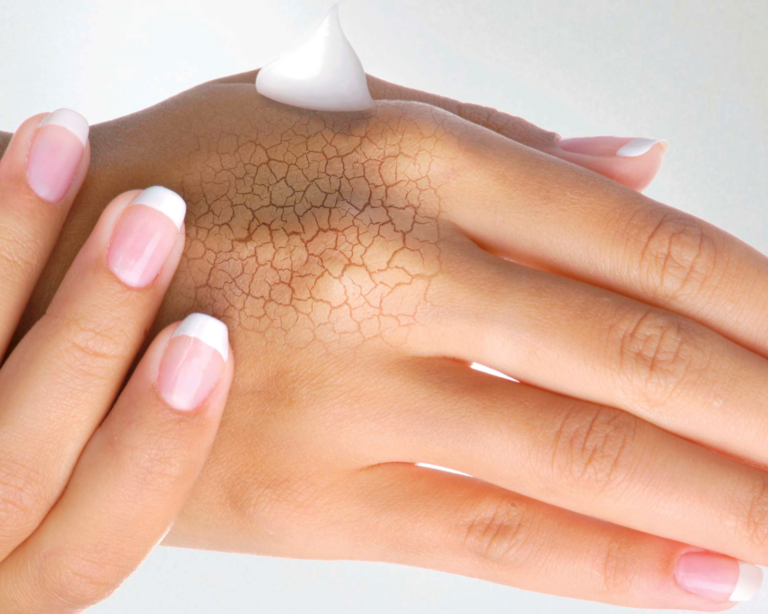Overview: What is atopic dermatitis?
Neurodermatitis is one of the most common skin diseases. It is a chronic condition that often progresses in episodes. In the case of neurodermatitis, the skin is inflamed and loses its natural protective function, so that it is insufficiently armed against external influences. The inflammations cause germs and irritating substances to penetrate the skin, which can sometimes lead to severe infections.
Neurodermatitis is also called atopic dermatitis or atopic eczema. Experts understand atopic disease or atopy as diseases in which the immune system reacts hypersensitively to normal environmental influences. In addition to neurodermatitis, these include hay fever, asthma and food allergies. These diseases can also often occur simultaneously or sequentially. The itching for people suffering from atopic eczema can be unbearable. When those affected scratch themselves, this usually only provides relief for a short moment and puts additional strain on the irritated skin. Scratched areas open the way for germs. A vicious circle.
Neurodermatitis – frequency and age
In Switzerland, 5 to 15 percent of people suffer from neurodermatitis, including children, toddlers and babies. In many cases, the symptoms become weaker or disappear completely over the years. Consequently, atopic dermatitis occurs less frequently in adults (less than 6 percent). Those who are affected in older years usually already suffered from neurodermatitis in childhood.
It is unclear why more people suffer from neurodermatitis today than in past decades. In this regard, there is the so-called hygiene hypothesis, which states that children who grow up on the farm are less susceptible to atopic diseases. Therefore, due to our life change to the cities with more and more cleanliness, there is an increasing number of atopy. It can also not be excluded that specialists pay more attention to atopic eczema today and therefore diagnose atopic dermatitis more often than in the past.
Neurodermatitis: causes and risk factors
Studies have shown that hereditary predisposition plays an important role. If you suffer from neurodermatitis, there may also be sufferers in your family. Children whose parents are both atopic dermatitis sufferers have the greatest risk of developing the disease. Science assumes that different genes on different chromosomes are responsible for whether a person has a predisposition to atopic dermatitis. Nevertheless, atopic dermatitis is not a typical hereditary disease; it can also occur on its own.
In many patients, a gene that has changed in such a way that it inhibits the production of a certain protein plays a special role. This protein, called filaggrin, is involved in the cornification of skin cells and regulates the composition of skin lipids. When the body produces too little filaggrin, the skin does not have enough moisture and dries out.
The exact cause of atopic eczema is unknown, but there are numerous factors that can trigger and promote atopic dermatitis. Which factors apply to you if you or a loved one is affected can vary widely. Common factors include:
- contact with wool or other textiles that irritate the skin
- too frequent washing with soap or contact with detergents
- Tobacco smoke
- certain foods to which the organism is sensitive
- Heat, sultriness, cold or other temperature and humidity conditions.
- Psychological stress
Symptoms: Neurodermatitis
If you suffer from neurodermatitis yourself, you are certainly familiar with dry, red, cracked and above all itchy skin. Sometimes scales, oozing blisters or nodules are added. Completely different areas of the skin can be affected.
- In adults, the flexor folds of the back of the knee and the crook of the elbow are often affected. The face, neck, wrists and hands are also often affected. A special form of atopic dermatitis is the prurigo form (prurigo atopica): These are intensely itchy nodules that have spread over larger areas of skin or even the entire body (and are often scratched).
- In children and adolescents, atopic dermatitis often becomes visible on the inner sides (flexural folds) of the knee and elbow joints. The face is less frequently affected.
- In infants, an early form (preform) of atopic dermatitis often appears as so-called cradle cap; in this case, the skin forms yellowish-white crusts. Typical areas for atopic eczema are the cheeks, scalp, and the outer sides of the arms and legs. The abdomen and back are less frequently affected. The atopic skin of infants is usually not as dry as that of children and adolescents, and it is usually less prone to scaling.
Atopic dermatitis (neurodermatitis) can be a major psychological burden and severely restrict quality of life. The condition can lead to impairments at work and school and even trigger depression or other psychiatric illnesses. In children, agonizingly itchy skin is a common cause of sleep disorders. Children who suffer from atopic eczema have a greater risk of developing psychological problems or ADHD than children without atopic eczema.
However, not all severely itchy dry skin redness is atopic eczema. For example, it could also be psoriasis, contact dermatitis or scabies. Therefore, it is important that you, as an affected person, consult an experienced dermatologist. Only if the family doctor or dermatologist makes the correct diagnosis, you can be helped with neurodermatitis with the appropriate therapy for you.
Online skin check: Quick and convenient from home
Send a photo of the affected skin area and fill out the short questionnaire. Within 24 hours on weekdays, you will receive a reliable diagnosis from our experts. Your data will be transmitted to us encrypted and treated confidentially.
Diagnosis neurodermatitis
We can tell if you have atopic dermatitis not only by looking at your skin. Other external features also indicate this:
- Shadows over the eyes (easily mistaken for an overtired appearance).
- a Dennie-Morgan wrinkle (two wrinkles – rarely one – below the lower eyelid)
- thickened skin with deepened lines in the palms (so-called ichthyosis hands)
However, these are not sure indicators that can replace an accurate diagnosis. Therefore, we will ask you about your exact medical history (anamnesis). Important are your own complaints (since when, how often, how strong, what triggered) and possible co-factors (for example allergies). In addition, we will also want to know from you if there are any cases of neurodermatitis, hay fever, asthma or other allergies in your relatives.
Finally, an examination of the entire skin should allow us to make a definitive diagnosis. It may also be necessary to take a tissue sample (biopsy). Allergic skin tests (prick tests) and blood tests are used to detect atopy.
Neurodermatitis: allergic form
In a large proportion of people suffering from atopic dermatitis (neurodermatitis), the immune system reacts sensitively to allergens. These are substances that can trigger allergies. Common allergens include pollen, dust mites, animal dander and certain foods. In these atopic dermatitis sufferers, an increased amount of a certain immune body can be detected in the blood (antibodies of the type immunoglobulin E, known as IgE for short). The IgE stimulates the organism to release pro-inflammatory substances.
If you are one of those affected whose IgE levels in the blood are elevated, then you suffer from the so-called extrinsic form of neurodermatitis. Non-allergic atopic dermatitis, on the other hand, is called intrinsic. We can find out which of the two forms you are using various tests:
- A blood test in the laboratory shows whether there is an abnormal IgE content in the blood.
- A skin test shows whether there is hypersensitivity (allergy) to certain substances. A frequently used allergy test is the prick test: In this test, various substances suspected of triggering an allergy are brought into direct contact with the skin one after the other. Allergic reactions then appear in the form of redness and swelling (wheals).
Neurodermatitis: prevention, early detection, prognosis
Preventing neurodermatitis by preventive measures alone is hardly possible. Consistent skin care from infancy onwards is very important for children at risk. Even in adulthood, consistent skin care is the basis of any therapy. Another measure that can be taken with infants is to pay attention to their diet by breastfeeding them for the first four to six months and not giving them any foreign protein (cow’s milk, for example) during this time. An alternative to breastfeeding is hypoallergenic infant formula. Babies who are fed this way in the first months of life have a greater chance of not developing a common or severe form of atopic dermatitis.
Adolescents and adults should especially avoid the risk factors already mentioned. Only if you know the substances that exert an undesirable stimulus on your organism, you can escape them to keep your neurodermatitis at bay.
Course and prognosis of neurodermatitis
About half of all neurodermatitis sufferers become ill in the first six months of life. Around 70 to 85 percent develop the disease before the age of five. Each neurodermatitis is different, each ill person has his own disease. There are varying lengths of pauses between relapses, and individual relapses can vary in severity and duration.
For many people suffering from neurodermatitis, the symptoms become weaker over the years or even disappear completely. This is especially true for those affected in the first twelve months of life. About 60 percent of children suffering from atopic dermatitis no longer have symptoms by early adulthood.
A complete cure for atopic dermatitis is not yet possible, since a predisposition to atopic dermatitis exists throughout life. But with the right therapy for you, the chances are good that you will live a life largely free of symptoms.
Self-help groups
The exchange with people who are affected by the same disease can be a great support in coping with the disease. Advice on finding a suitable self-help group is available from Selbsthilfe Zürich. Self-Help Zurich and the University Hospital Zurich are cooperation partners in the national project “Health literacy thanks to self-help-friendly hospitals”.
Neurodermatitis: effective treatment
There are several effective ways to relieve atopic eczema. Some things you can do yourself. We have several treatment options available to us, including medications. Which one we choose depends on the degree of expression and your individual circumstances. One remedy alone is usually not able to relieve atopic dermatitis.
When treating your neurodermatitis, we distinguish between two basic types of therapy:
- external treatment (with ointments, creams, UV light)
- the internal treatment (with medicines)
In mild to moderate relapses, external treatment is usually sufficient; we will choose internal treatment, also called systemic therapy, mainly in a more severe course.
Neurodermatitis: effective treatment

